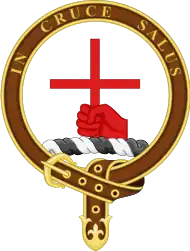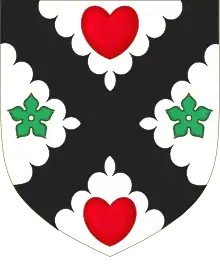Clan Tailyour
Clan Tailyour,[1] also known as Clan Taylor,[2] is a Scottish clan. The clan is recognized by the Lord Lyon King of Arms but it does not currently have a clan chief therefore it is considered an armigerous clan.[1] The surname Taylor is also considered a sept of the Clan Cameron of the Scottish Highlands who are descendants of Taillear Dubh na Tuaighe (b.1550), see: Taylor sept.
| Clan Tailyour | |||
|---|---|---|---|
| Macintaylor[1] | |||
 | |||
| Motto | In Cruce Salus (Salvation from the cross)[2] | ||
| Clan Tailyour no longer has a chief, and is an armigerous clan | |||
| Historic seat | Kirktonhill Castle[3] | ||
| |||
History
Origins of the clan


Scottish Clan & Family Encyclopedia. 1994.

Scottish Clan & Family Encyclopedia. 1994. The surname Tailyour is derived from the French tailler which means to cut.[1] In Latin it is rendered as cissor.[1] In around 1137 Walter Cissor received a grant of land from David I of Scotland.[1] The historian George Fraser Black states that Taylor is a very common name in early Scots records.[1] In 1276 Alexander le Taillur is listed as valet to Alexander III of Scotland.[1]
Wars of Scottish Independence
In 1296 Bryce le Taillur was one of the Scottish prisoners at the capture of Dunbar Castle.[1] In the same year six people of this name appear on the Ragman Rolls, rendering homage to Edward I of England, from counties as far apart as Angus and Roxburgh.[1]
15th, 16th 17th and 18th centuries
In the Latin form of then name Cissor, both Donald Cissor and Bricius Cissor were witnesses to a deed in Inverness in 1462.[1] In around 1552 Gillepatrick Tailzeour was sergeant of Dornoch.[1] The name is also found rendered as Macintaylor and in 1613 several Macintaylors were fined for sheltering outlawed members of the Clan Gregor.[1]
James Taylor, born 1753 in Lanarkshire is credited with the first practical application of steam power to vessels for inland navigation.[1] The great paddle steamers which would later carry passengers and freight on the rivers of North America were derived from Taylor's original work.[1]
Castles
Kirktonhill is situated within Aberdeenshire, some four and a half miles north of Montrose, Angus, and lies directly east of the village of Marykirk. There was a castle at Kirktonhill which had been held from the 18th century by the Taylors, who had made money from sugar plantations in Jamaica.[3] This was replaced by Kirktonhill House, a mansion that itself was demolished in the 1960s.[3] Nearby is Kirktonhill Tower, a three-story folly.[3]
References
- Way, George and Squire, Romily. (1994). Collins Scottish Clan & Family Encyclopedia. (Foreword by The Rt Hon. The Earl of Elgin KT, Convenor, The Standing Council of Scottish Chiefs). pp. 463.
- Clan Taylor Profile scotclans.com. Retrieved 13 September 2014.
- Coventry, Martin. (2008). Castles of the Clans: The Strongholds and Seats of 750 Scottish Families and Clans. pp. 569. ISBN 978-1-899874-36-1.